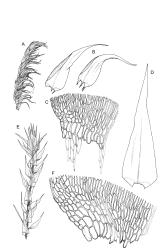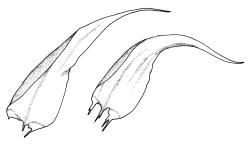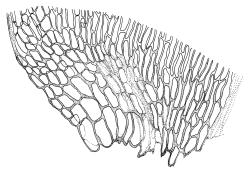- ≡ Hypnum aduncum Hedw., Sp. Musc. Frond. 295 (1801)
- = Hypnum polycarpon Voit in Sturm, Deutschl. Fl. (Sturm), Abt. 2, Cryptog. 14, 13 (1813)
- ≡ Drepanocladus polycarpos (Voit) Warnst., Beih. Bot. Centralbl. 13: 399 (1903)
Plants rather small to medium-sized, yellow- or brown-green, forming loose wefts. Stems mostly ascendant in self-supporting wefts, commonly c. 50 mm, distichously and subpinnately branched, in cross-section with c. 4–5 layers of small and incrassate outer cells and a small central strand; cortical cells often stripping off with the leaves (especially at base of costa). Stem leaves falcate-secund, closely spaced, (1.3–)2.5 × 0.75 mm (under cover slip), ovate-lanceolate and gradually tapered to a rather short acumen, narrowed to insertion, plane to somewhat inrolled at margins, not striolate when dry, entire, not decurrent; mid laminal cells smooth, vermicular, c. 30–51 × 2.5–4 µm, firm-walled, eporose, rounded at ends, not differentiated at margins or at leaf apex; basal laminal cells usually wider (c. 9–12 µm) but not otherwise differentiated; alar cells strongly inflated and hyaline to yellow-brown, forming a triangular and auriculate group extending ⅔ to the entire distance to the costal base and grading abruptly into the adjacent basal laminal cells. Costa rather narrow and ill-defined, c. 45–60 µm wide near base, mostly reaching mid leaf or somewhat beyond. Branch leaves mostly smaller, often circinate at branch tips.
Dioicous. Perichaetia scattered on stems, c. 1 mm long (prior to fertilisation), the outer leaves short and obtuse, the inner leaves narrowly ovate-lanceolate, acuminate, and weakly costate. Perigonia and capsules not seen.
Seppelt 2004, figs. 46–48; Crum & Anderson 1981, figs. 467–468; Żarnowiec 2001, figs. 57–61, 63.
The monograph of the D. aduncus complex by Żarnowiec (2001) promoted narrower species concepts than those accepted here. This monograph provides remarkably detailed illustrations and descriptions of this species (and of D. polycarpus, which is not accepted here).
Hedenäs’ (2003) decision to subsume D. polycarpus (Voit) Warnst. within D. aduncus is accepted here. Seppelt (2004) tentatively accepted the concepts of Żarnowiec (2001), treating D. polycarpus ["D. polycarpos"] as a distinct species in his treatment of Macquarie I. mosses. Hill (2003) considered the criteria (primarily the length of mid-laminal cell length) used by Żarnowiec for distinguishing D. polycarpus ["D. polycarpos"] from D. aduncus in British material, concluding that cell dimensions were subject to environmental variation and that D. polycarpus was not deserving of recognition. Hill cited cultivation experiments and similar conclusions reached by Hedenäs (1996).
NI: N Auckland, Gisborne (Lake Waikaremoana), Hawke’s Bay, Wellington; SI: Nelson, Marlborough, Canterbury, Westland, Otago; M.
Nearly cosmopolitan. Widespread in the northern hemisphere (Buck 1998). Reported as widespread in Australia (Scott & Stone 1976). Material from other Land Districts cannot be confirmed since it is either sterile or referable to D. brachiatus (e.g., most material from S Auckland L.D. is D. brachiatus).
Occurring in a wide variety of habitats, but usually associated with cation enriched or calcareous wetlands. Often in fens, in damp depressions on river beds, lake margins, and Carex secta-dominated swamps. Usually on damp ground or emergent from shallow and ± still water, but sometimes submerged (and then usually with ± straight leaves, as discussed below). Apparently ranging from near sea level to at least 1400 m (Temple Basin, Canterbury L.D.) for falcate plants and to at least 1800 m (Pisa Range, Otago L.D.) for straight-leaved forms.
The most frequent growth form of this species in N.Z. has falcate-secund, closely spaced leaves with costae mostly reaching mid leaf or somewhat beyond, strongly inflated alar cells extending nearly to the base of the costa, and cortical cells which adhere to the stripped-off leaves.
The perichaetial leaves in D. aduncus enlarge significantly during the capsule maturation process. This is probably universal in the genus and perhaps the family.
Material growing submerged or in sites with fluctuating water levels is problematic. Such material occurs at many scattered localities in N.Z. and is usually slender and sparsely branched, with leaves usually widely spaced, widely spreading, ± straight (not secund at stem and branch tips). The alar cells are usually well-differentiated, but can be somewhat variably developed (even in one population), the costae usually extend slightly past mid leaf, and the lower portions of the plants often very pigmented. Such straight-leaved material is almost invariably sterile. These plants are considered here to be environmental variants and not worthy of taxonomic recognition in N.Z. Much of this straight leaved material is similar to what has been dubbed D. aduncus var. kneiffii in the northern hemisphere by some authors (e.g., Crum & Anderson 1981). The var. kneiffii was discussed by Sainsbury (1955, p. 424), who decided not to recognise it in the N.Z. flora; I concur with this decision. Some N.Z. specimens, however, have been assigned to var. kneiffii by other workers in herb. An argument could be presented that some of the straight-leaved material belongs to D. brachiatus, but I think that attempts to assign straight-leaved material to that species using morphological characters alone would be a wasted effort. Straight-leaved plants can also be difficult to differentiate from Leptodictyum riparium or even from Warnstorfia fluitans.
Hedenäs (2003, p. 68) gave a wider range of median laminal cells dimensions than noted above and characterised D. aduncus, in part, by the ratio of the mid leaf laminal cell length (in µm) to the leaf length (in mm). There is too much overlap in this character for it to be of practical value in N.Z. material.










